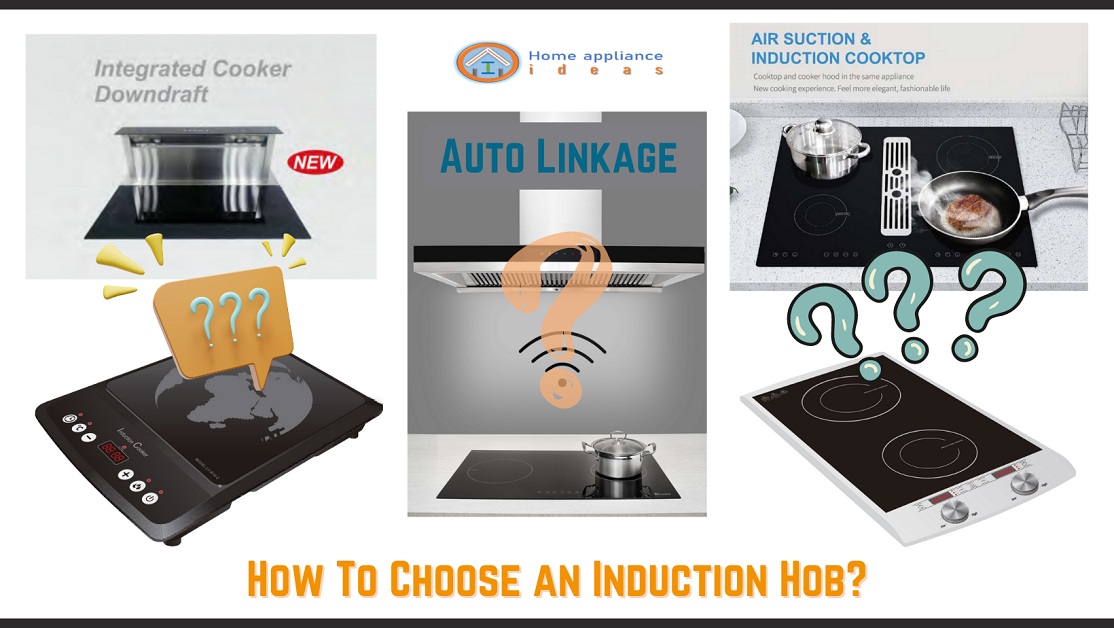Today I will walk you through on how to choose an induction hob!
I’m sure you already got an idea that induction cooktops are not that cheap of a product.
With that said…
I will show you relevant information that would help you when choosing an induction hob.
So that you’ll only get the right one for your home kitchen.
Let’s begin!
Let me show You how to choose an Induction Hob
Ask yourself these questions to help you out when choosing an induction hob!
- What size of induction hob will be suitable for your kitchen?
- There are many sizes available and you’ll need to make sure you get the right size that would fit in your kitchen!
- Are you looking for a Freestanding or Built-in type?
- Firstly, you must identify what type you will need!
- Freestanding induction hobs offer portability — basically, you can move this type of induction cooker anywhere you want it.
- Built-in induction hobs are fixed — you won’t be able to move this type of induction cooker after installation!
- Will this be your primary cooker or is it just an alternative one?
- If you are looking for an induction hob to be your primary cooker — then you would want to have a minimum of at least 2 cooking zone or more!
- If it is just an alternative to complement your primary cooker, then a single induction hob could be the answer!
- What is your budget?
- It’s no secret that induction hobs are expensive — however, you’d want to ensure to only choose the type that meets your need!
- Remember, the more features the induction hob has, the more expensive it will become!
- Induction hobs with higher power rating will be more expensive!
- The more cooking zones an induction cooker has — the more expensive it will be!
With the above outlined questions and explanation…
Let’s deep dive to find out more details that you could use to help you out further.
Because the better you understand more about induction cookers, the better your odds of getting the right one that fits your need!
Understanding Standard Size of Induction Hobs
First to take note is that “standard size” is more relevant to the “built-in” types of induction hobs!
Below are the most common known standard sizes for induction hobs:
- 30 cm (Domino type)
- Common for double induction hobs
- 60 cm
- Normally used for 3 and 4 cooking zones
- 77 cm
- This became a popular size (for minimalists) that sees 90cm as too big
- Best utilized for 4 cooking zones induction hobs
- 90 cm
- Common size for 5 cooking zones induction cooktops
- Some suppliers have design that can accommodate 6 cooking zones
While some manufacturers may have other available sizes based on the customers’ requirements — but the above-mentioned are the most commonly utilized sizes by many (if not all), that can be found in the market!
Furthermore, the above sizes normally indicate the WIDTH of the induction hob — and most manufacturers are following this as a reference to designate dimensions (Width x Depth x Height).

Note: Some suppliers may have different terminology and will use LENGTH (Length [instead of Width] x Width [instead of Depth] x Height) as their basis for identifying the dimension!
This is very important not to confuse due to the cut-out that has to be outlined on the countertop that will be needed during the induction hob installation!
When to consider Single Induction Hob?
If you want portability — then a single induction cooker will best fit this role to complement your primary cooker (e.g. gas hob, gas range, etc).
While built-in designs may be available, but the single induction cookers are widely utilized as freestanding types!
Below are common designs that you will find for single induction hobs.
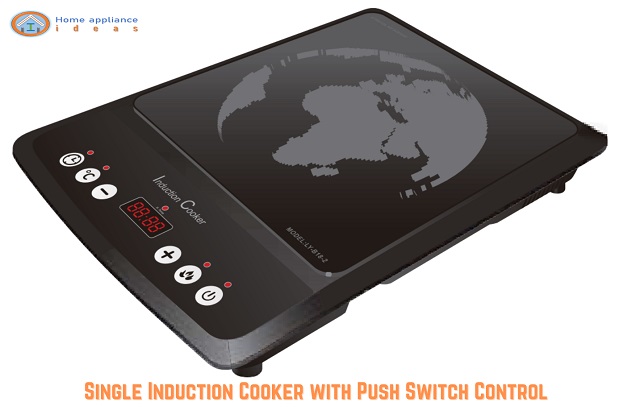
The above image is an example of a single induction hob with Push Switch Control.
Another design is utilizing the Touch Control…
Below is an example of a single induction hob with Touch Control.
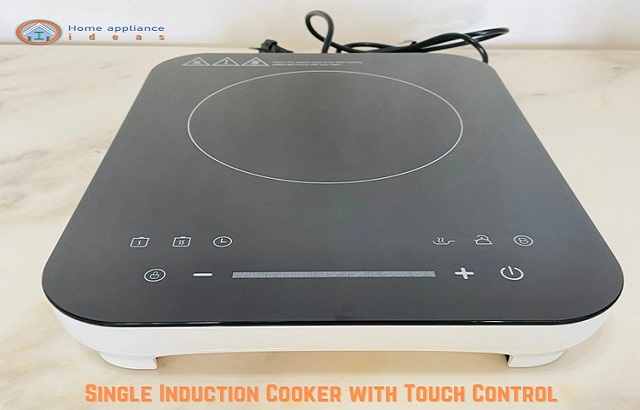
This is my single induction hob that I use as a backup, but more importantly for hotpot cravings.
I have in my kitchen a double gas burner (as my primary cooker) that was readily installed by the building developer as part of the contract.
Single induction hob’s sizes are not standard — their size is dependent on the design!
Double Induction Hobs
So, if you’d want to check on this one — double induction cookers are available both as Freestanding and Built-in!
See below examples for reference.
1) Freestanding Double Induction Hobs
The freestanding double induction hob size also varies according to design, as illustrated in the below photo.

While a lot bigger than the single induction hobs — it is still portable enough that you can place it anywhere you want.
Since the power supply cable still comes with a plug, so you can use it anywhere in your kitchen!
The most popular designs nowadays are with touch controls…
while just utilizing standard induction coils to make it more affordable for the consumers!
2) Built-in Double Induction Hobs
Unlike the freestanding, the power supply cord for built-in types does not come with a plug!
This is common and not a problem!
And the design that has been gaining popularity is the built-in double induction hob (domino type). Below are examples:
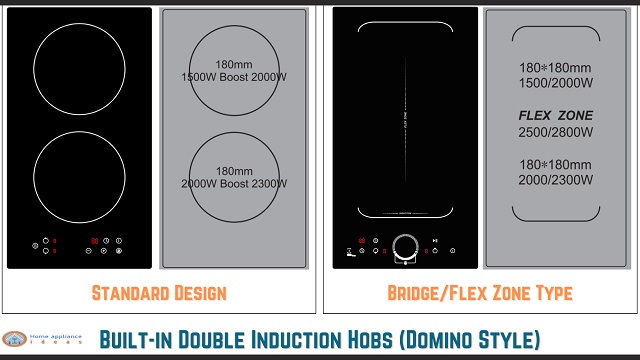
There are two designs that are currently available for domino type of built-in double induction cookers.
As illustrated in the above photo, they are the following:
- Standard (induction coil) Design
- The two induction coils are fixed!
- You need to place the cookware at the center of the cooking zone so that it can be detected!
- If the cookware is not centered — the sensor won’t recognize it and will send an error of missing pot/pan (learn more how induction cooker works)!
- Available Size: 30cm
- Bridge/Flex Zone (induction coil) Design
- The two induction coils are flexible!
- The induction hob would still work even if you have placed the cookware off-centered or at any position in the cooking area!
- More expensive than the standard design!
- Available Size: 30cm
Three Cooking Zone Induction Hob
With the three cooking zone induction hob it gives you more cooking flexibility!
This design is more geared to built-in types, and rarely you will see a freestanding model.
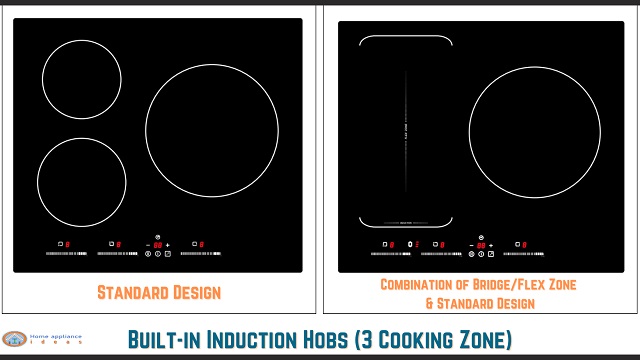
And like other built-in induction cooktops, the power cable also does not have a plug!
There are two common designs that are available for this kind of induction hob, they are:
- Standard (induction coil) Design
- The three induction coils are fixed!
- You need to place the cookware at the center of the cooking zone so that it can be detected!
- If the cookware is not centered — the sensor won’t recognize it and will send an error of missing pot/pan!
- Popular Size: 60cm
- Bridge/Flex Zone and Standard (induction coils) Design Combined
- The two induction coils are flexible zone while the third is fixed coil!
- At the Bridge/Flex zone area, the induction hob would still work even if you have placed the cookware off-centered or at any position in the free zone cooking area!
- On the third cooking zone — you need to place the cookware at the center so that it can be detected (if not, the sensor will not recognize that there’s pot/pan, instead it will send an error signal of missing pot/pan)
- More expensive than the standard design!
- Popular Size: 60cm
Four Cooking Zone Induction Hob
A four cooking zone induction hob (built-in type) is very popular for new and remodeled homes!
While more and more building developers have tapped four cooking zones induction cooktops as the primary cooker of choice in their kitchen design.
In my last job working as a product expert for the home appliance department, I sourced and developed models for clients in Vietnam and Thailand.
There are three options for this type, as shown in the example picture below.

- Standard (induction coil) Design
- The four induction coils are fixed!
- You need to place the cookware at the center of the cooking zone so that it can be detected!
- If the cookware is not centered — the sensor won’t recognize it and will send an error of missing pot/pan!
- Popular Size: 60cm, 77cm
- Bridge/Flex Zone and Standard (induction coils) Design Combined
- The two induction coils are flexible zone while the other two coils are fixed coils!
- At the Bridge/Flex zone area, the induction hob would still work even if you have placed the cookware off-centered or at any position in the free zone cooking area!
- On the third and fourth cooking zones — you need to place the cookware at the center so that it can be detected (if not, the sensor will not recognize that there’s pot/pan, instead it will send an error signal of missing pot/pan)
- This is more expensive than the standard design!
- Popular Size: 60cm, 77cm
- Bridge/Flex Zone (induction coils) Design
- All the four induction coils are flexible coils!
- At the Bridge/Flex zone area, the induction hob would still work even if you have placed the cookware off-centered or at any position in the free zone cooking area!
- This is a more expensive choice than the standard and the combined design!
- Popular Size: 60cm, 77cm
Five Cooking Zone Induction Hob
For a bigger kitchen design, the five-cooking zone (built-in) induction hob could be well-suited.
You could benefit from a five-cooking zone induction hob, especially if you are cooking for a big family.
Because it will give you the ability to cook more food simultaneously.
There are two options available.
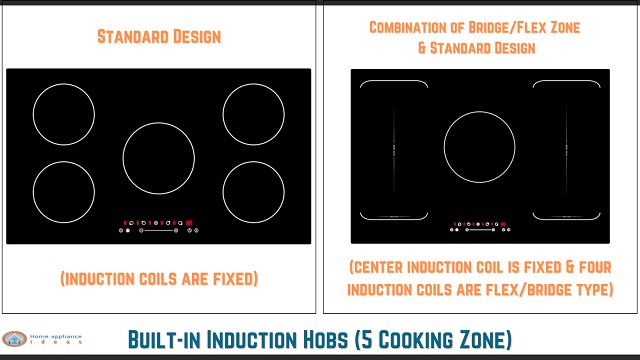
- Standard (induction coil) Design
- All the five induction coils are fixed!
- You need to place the cookware at the center of the cooking zone so that it can be detected!
- If the cookware is not centered — the sensor won’t recognize it and will send an error of missing pot/pan!
- Popular Size: 90cm
- Bridge/Flex Zone and Standard (induction coils) Design Combined
- The four induction coils on both sides are flexible zone while the cooking zone at the middle is a fixed induction coil!
- At the Bridge/Flex zone area, the induction hob would still work even if you have placed the cookware off-centered or at any position in the free zone cooking area!
- On the middle cooking zone — you need to place the cookware at the center so that it can be detected (if not, the sensor will not recognize that there’s pot/pan, instead it will send an error signal of missing pot/pan)
- This is more expensive than the standard design!
- Popular Size: 90cm
Other Possible Options
Apart from the regular designs discussed above, there are also other options (special designs) that you can consider — only if you have the budget!
Six Cooking Zone Induction Hob
It’s very rare to see a design with six cooking zones on it!
But some manufacturer do have this option — incorporating the Flex zone induction coils!
- Bridge/Flex Zone (induction coils) Design
- All the six induction coils are flexible coils!
- At the Bridge/Flex zone area, the induction hob would still work even if you have placed the cookware off-centered or at any position in the free zone cooking area!
- This is a more expensive choice with all six Bridge/Flex induction coils!
- Available Size: 90cm
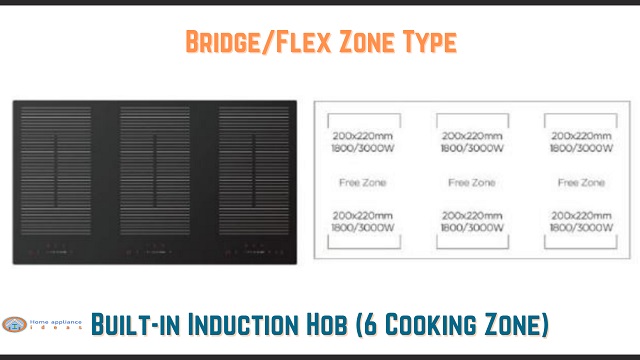
In my opinion, by utilizing the flex zone induction coils makes sense —
because it allows the user to place the cookware anywhere, which makes it more convenient when cooking.
Integrated Induction Hob and Downdraft Hood
Another special design is the integration of induction cooker and downdraft cooker hood.
While this choice will be expensive for sure…
But it gives your kitchen an elegant and distinctive look!
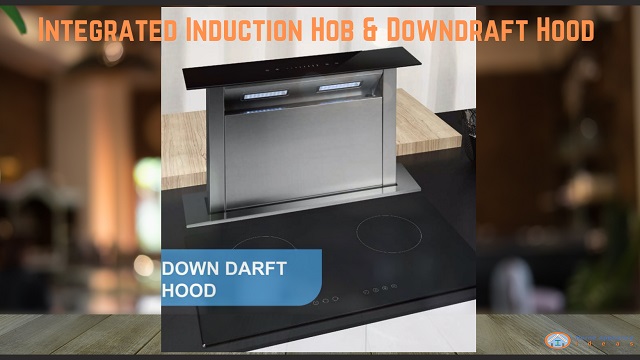
As shown in the above image, manufacturers use a double induction hob to incorporate a downdraft hood!
Integrated Induction Hob and Down-Air Suction Hood
Unlike the downdraft style, where the hood will rise when the hood is turned On — the down-air suction hood is fixed, and the smoke is sucked out through the vent openings and down to the exhaust tube.
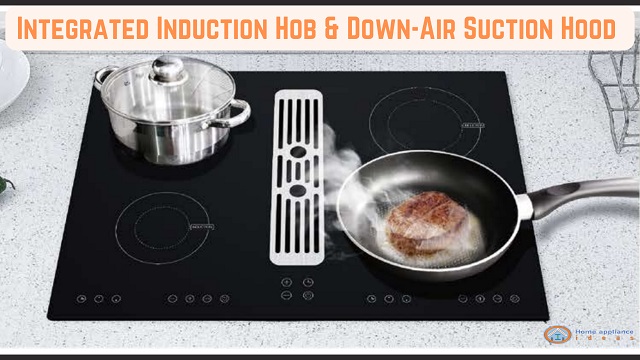
As exhibited above, manufacturers use the four-cooking zone induction hob to match and fully utilize the purpose of the down-air hood.
Auto Linkage Induction Hob and Cooker Hood
This design is another special one — because you need to buy at the same time the induction hob and the cooker hood to work.

Thus, this design is expected to be more expensive as you also need to purchase the cooker hood!
Common Specs and Features of Induction Cooktop
So, now let’s find out what are the common specification and features of an induction hob.
| Spec/Feature | Basic Design | Premium Design |
|---|---|---|
| Boost | ✅ | ✅ |
| Individual Timer | ✅ | ✅ |
| Pan Sensor | ✅ | ✅ |
| Auto Safety switch OFF | ✅ | ✅ |
| Residual heat indicator | ✅ | ✅ |
| Child Lock | ✅ | ✅ |
| Multi-stage Power setting | ✅ | ✅ |
| Touch/Slider Control | ✅ | ✅ |
| Bridge/Flex zone | – | ✅ |
| Keep warm | – | ✅ |
| Overflow Protection | – | ✅ |
The above lists of features/specs are common that every induction hob manufacturer could offer.
And there could be more features to it — if the client wants to add them and if it’s doable!
Among the latest Bridge and Flex zone designs — most manufacturers are integrating half-bridge technology that generates constant heating to ensure better cooking performance!
And as I’ve said, the more features the induction cooker has, the pricier it will get!
What is the best wattage for an induction cooktop?
If you have noticed in my above examples where the power rating is included in the illustration — the most utilized power is 1500W, 1800W, and 2000W.
But realistically, the power rating combination will all depend on the design!
On the other hand, the most common maximum wattage for single induction hobs is 1800W.
One good example is my induction cooker — it has a maximum power of 1800W!
Final Thoughts
There you see my round-up in choosing an induction hob for home use.
I have provided the basic questions and explanations that will guide you!
Here are the takeaways:
- Know exactly what you need!
- You must have a flexible budget because the model that you might want to have will cost more!
- You always have an alternative with a basic design if you have a limited budget!
I hope you find these ideas for choosing an induction cooktop helpful!
So, there you have it, folks!
If you have any questions or suggestions, or if you feel some information is lacking…
please leave them in the comments below, and I will answer them as soon as I can and to the best of my knowledge.
Thanks!
